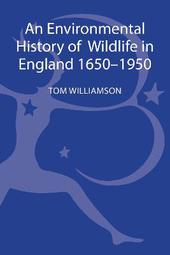
|
An Environmental History of Wildlife in England 1650 - 1950
Hardback
Main Details
| Title |
An Environmental History of Wildlife in England 1650 - 1950
|
| Authors and Contributors |
By (author) Professor Tom Williamson
|
| Physical Properties |
| Format:Hardback | | Pages:296 | | Dimensions(mm): Height 234,Width 156 |
|
| Category/Genre | British and Irish History
The environment |
|---|
| ISBN/Barcode |
9781441108630
|
| Classifications | Dewey:333.70942 |
|---|
| Audience | |
|---|
| Illustrations |
25
|
|
Publishing Details |
| Publisher |
Bloomsbury Publishing Plc
|
| Imprint |
Bloomsbury Academic USA
|
| Publication Date |
5 December 2013 |
| Publication Country |
United States
|
Description
Choice Outstanding Academic Title 2014 While few detailed surveys of fauna or flora exist in England from the period before the nineteenth century, it is possible to combine the evidence of historical sources (ranging from game books, diaries, churchwardens' accounts and even folk songs) and our wider knowledge of past land use and landscape, with contemporary analyses made by modern natural scientists, in order to model the situation at various times and places in the more remote past. This timely volume encompasses both rural and urban environments from 1650 to the mid-twentieth century, drawing on a wide variety of social, historical and ecological sources. It examines the impact of social and economic organisation on the English landscape, biodiversity, the agricultural revolution, landed estates, the coming of large-scale industry and the growth of towns and suburbs. It also develops an original perspective on the complexity and ambiguity of man/animal relationships in this post-medieval period.
Author Biography
Tom Williamson is Professor of History at the University of East Anglia, UK. His many publications include The Transformation of Rural England (2002) and Shaping Medieval Landscapes: Settlement, Society, Environment (2003).
ReviewsAn Environmental History... is an engaging read, written with clarity and care, and with only the minimum use of specialized vocabulary. -- Terry O'Connor, University of York, UK * Institute of Historical Research, Reviews in History * Williamson has done a service to anyone interested in the impact of agricultural, industrial and social change on the diversity of England's wildlife, whether native, non-native or naturalising. No one could walk away from a careful reading of the book thinking that it is easy to distinguish natural from artificial landscapes, or that the history of English wildlife lends itself to simple narratives of either progress or decline. -- Etienne Benson, University of Pennsylvania * Environment and History *
|